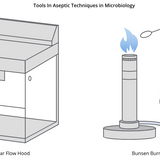What is an Agar Plate?

Agar plates are important tools in microbiology used by researchers and scientists to study microorganisms. These plates consist of a petri dish with growth medium made of agar. They provide a controlled environment for microbial growth, including bacteria and fungi.
The medium is made up of solidified agar, which is derived from seaweed. It is often enriched with proteins, carbohydrates and minerals. This provides support for microorganisms to grow. Agar is ideal for culturing microbes because it has high melting point and is resistant to degradation.
After the mixture of melted agar and nutrients is poured into a petri dish and solidified, it forms a suitable surface for microbial growth. The plates are incubated at specific temperature and humidity. This supports the growth of the microbes.
Applications of Agar Plates
Agar plates are used for the study of microorganisms and molecular biology. They are often used in various applications, including:
- Culturing and isolating microorganisms: Agar plates are used to grow and isolate cultures for studying different species of bacteria and fungi.
- Quantitative analysis: Agar plates can be used to estimate the concentration of microorganisms in a sample. The colony counting can be done using colony counters.
- Selection and screening: Antibiotics or specific nutrients can be added to agar plates. These influence the growth of specific microorganisms.
- Pathogen detection: Agar plates are necessary in detecting and studying pathogens in contaminated food and water.
Types of Agar Plates
From general-purpose growth to selective diagnostics, agar plates can be tailored to specific needs of the research. Different types differ in their colour and they also require variable conditions for the incubation, depending on the microbe.
Nutrient Agar Plates
Nutrient agar plates are the most common. They support the growth of a wide variety of microorganisms, including bacteria and fungi. Apart from beef extract and protein digests, agar is added as the gelling agent. This type is ideal for general-purpose culturing and observation of microorganisms that don not have complex nutritional requirements. Nutrient agar plates are often used in laboratories for teaching and experiments.
Selective Agar Plates
Selective agar plates support the growth of specific microorganisms while suppressing the growth of others. Selective media is important in diagnostics, industrial microbiology and environmental microbiology. It is used to isolate organisms in mixed populations.
MacConkey Agar
MacConkey Agar contains bile salts and crystal violet. It is selective for gram-negative bacteria and suppresses the growth of gram-positive bacteria. Very often, this type is used in clinical diagnostics.
Eosin Methylene Blue (EMB) Agar
EMB agar is also selective for the growth of gram-negative bacteria and suppresses the growth of gram-positive bacteria. Eosin and methylene blue are added as dyes. They help differentiate organisms based on their lactose fermentation.
Differential Agar Plates
Differential agar plates allow researchers to differentiate between microbial species. These plates are useful in microbial identification and telling pathogenic strains apart. The compounds within the plate are metabolized differently by organisms. These cause visible changes in colony morphology or color.
Blood Agar Plates
Blood agar plates contain differential media that supports growth of fastidious organisms. The plates are composed of 5-10% of mammalian blood, added directly to the agar base. They are often used for the isolation of organisms or haemolysis analysis.
Chocolate Agar Plates
Chocolate agar is a special type of blood agar. The blood cells are lysed by heating, which turns the medium brown (they do not contain any chocolate). They are used to support the growth of respiratory pathogens.
Indicator Agar Plates
Indicator plates contain compounds that change color. The change occurs as a results of microbial activity. Within these plates, the substance interacts with the microbial enzymes and metabolic by-products. They are often used in food safety and water quality testing.
Requirements for Culturing Microorganisms
To successfully culture microorganisms, specific conditions are required:
Learn More
 What is Sterilization in Microbiology?
What is Sterilization in Microbiology?
Colony counting is a key technique used in microbiology, offering critical insights into microbial populations in various scientific and industrial fields. This method allows researchers and professionals to estimate the number of microbes in a sample. It is the easiest and most common way to estimate the number of cells in a sample.
Read more... What are Aseptic Techniques?
What are Aseptic Techniques?
Aseptic techniques are essential practices in microbiology and biotechnology. They prevent contamination of samples, equipment, and environments by unwanted microorganisms.
References
- E. Eyler Laboratory Methods in Enzymology: Cell, Lipid and Carbohydrate Methods in Enzymology, 2013